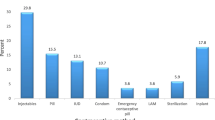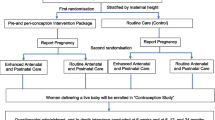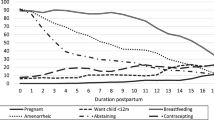Abstract
Over the past 15–20 years observations in many parts of the world have revealed a negative association between the natural protection afforded by lactational amenorrhoea and contraceptive uptake. This paper uses qualitative and quantitative data to explore the possible explanations for this nagative association in two Bangladeshi populations, one urban and one rural. The findings suggest that a subconscious substitution of contraceptive protection for natural protection against pregnancy is the most likely explanation. It appears that shorter durations of exclusive breastfeeding have led to earlier resumption of menses which in turn prompts the use of contraception. However, other mechanisms appear to play a subsidiary role, at least in the rural population. Moreover, changes in breastfeeding cannot be viewed as totally independent of the promotion of modern family planning. Evidence suggests that family planning staff are poorly equipped to support breastfeeding, and may often encourage the early introduction of supplements. There is a need to consider ways of promoting exclusive breastfeeding as well as ensuring ready access to contraception when fecundity resumes postpartum. Only such an integrated approach is likely to ensure that both negative effects on child health and unwanted pregnancies are avoided.
Similar content being viewed by others
References
Adnan, A.M. and S.A. Bakr. 1983. Postpartum lactational amenorrhoea as a means of family planning in the Sudan: a study of 500 cases.Journal of Biosocial Science 15(9): 9–23.
Baqui, A.H., K. Jamil and N.M. Jahangir. 1994.Urban Surveillance System, Dhaka: Methods and Procedure Urban FP/MCH Working Paper no. 2. Dhaka: ICDDR, B.
Becker, S. and S. Ahmed. 1994. The interaction of breastfeeding and contraception in Peru. Paper presented at the Annual Meeting of the Population Association of America, Miami.
Bhatia, S. and Y.J. Kim. 1982. The effect on fecundity of pill acceptance during postpartum amenorrhoea in rural Bangladesh.Studies in Family Planning 13 (6/7): 200–207.
Bhatia, S. and Y.J. Kim. 1984. Oral contraception in Bangladesh.Studies in Family Planning 15 (5): 233–241.
Bongaarts, J. and R.G. Potter. 1983.Fertility Biology and Behavior: An Analysis of the Proximate Determinants. New York: Academic Press.
Briend, A., V. Fauveau and J. Chakraborty. 1991. Contraceptive use and breastfeeding duration in rural Bangladesh.European Journal of Clinical Nutrition 45(7): 341–346.
Cleland, J., J.F. Philips, S. Amin and G.M. Kamal. 1994.The Determinants of Reproductive Change in Bangladesh: Success in a Challenging Environment. Washington DC: World Bank.
DaVanzo, J. and E.H. Starbird. 1991. Correlates of shorter interbirth intervals in Peninsular Malaysia: their pathways of influence through breastfeeding and contraceptive use.Studies in Family Planning 22(4): 241–254.
Fauveau, V. and J. Chakraborty. 1994. Family planning and maternal and child health services in Matlab. Chapter 6 in V. Fauveau (ed.),Matlab: Women, Children and Health. Dhaka: ICDDR, B.
Fronczak, N., S. Amin and Q. Nahar. 1993.Health Facility Survey in Selected Dhaka Slums. Dhaka: ICDDR, B.
Gomez de Leon, J. and J. Potter. 1989. Modelling the inverse association between breastfeeding and contraception.Population Studies 43: 69–93.
Hatcher, R.A., F. Stewart, J. Trussell, D. Kowal, G.K. Stewart and W. Cates. 1990.Contraceptive Technology: 1990–1992. 15th Edition. New York: Irvington.
Jain, A.K. and J. Bongaarts. 1981. Breastfeeding patterns, correlates and fertility effects.Studies in Family Planning 12: 79–99.
Jamil, K., A.H. Baqui, Q. Naharet al. 1994. Urban Surveillance System documentation: data collection instruments, Vol. 1. UHEP, ICDDR, B, Dhaka. Unpublished manuscript.
Jamil, K., A.H. Baqui and N. Paljoir. 1993.Knowledge and Practice of Contraception in Dhaka Urban Slums: A Baseline Survey. Dhaka: ICDDR, B.
Kaunitz, A.M. 1994. Long-acting injectable contraception with depo-medroxyprogesterone acetate.American Journal of Obstetrics and Gynecology 170(5): 1543–1549.
Knodel, J. and N. Debavalya. 1980. Breastfeeding in Thailand: trends and differentials 1969–1979.Studies in Family Planning 11 (12): 355–377.
Knodel, J., P. Kamnuansilpa and A. Chamtatrithirong. 1985. Infant feeding practices, postpartum amenorrhea, and contraceptive use in Thailand.Studies in Family Planning 16(6): 302–311.
Koening, M.A., J.F. Phillips, R.S. Simmons and M.A. Khan. 1987. Trends in family size preferences and contraceptive use in Martlab, Bangladesh.Studies in Family Planning 18(3): 117–127.
Koenig, M.A., U. Rob, M.A. Khan, J. Chakraborty and V. Fauveau. 1992. Contraceptive use in Matlab, Bangladesh in 1990: levels, trends and explanations.Studies in Family Planning 23(6): 352–364.
Laukaran, V.H. 1987. The effects of contraceptive use on the initiation and duration of lactation.International Journal of Gynaecology and Obstetrics 25 (supplement): 129–142.
Laukaran, V.H. and B. Winikoff. 1985. Contraceptive use, amenorrhea and breastfeeding in postpartum women.Studies in Family Planning 16(6): 293–301.
Mavalankar, D.V., R.H. Gray and C.R. Trivedi. 1993.Use of Family Planning during the First Year Postpartum in Ahmedabad, India. Ahmedabad: Indian Institute of Management.
Millman, S. 1985. Breastfeeding and contraception: why the inverse association?Studies in Family Planning 16: 61–75.
Mitra, S.N., M. Nawab Ali, S. Isiam, A.R. Cross and T. Saha. 1997.The Bangladesh Demographic and Health Survey 1993–4:Final Report: Dhaka: NIPORT, Mitra and Associates, Macro International Inc.
Perry, H., S. Begum, A. Begum, T.T. Kane, M.A. Quaiyum and A.H. Baqui. 1996.Assessment of Quality of the MCH-FP Services Provided by Field Workers in Zone 3 of Dhaka City and Strategies for Improvement. Dhaka: ICDDR, B.
Salway, S. 1996. Contraception following childbirth in Bangladesh. Ph.D. Thesis, University of London.
Salway, S., Q. Nahar and M. Ishaque. 1996.Women, Men and Infant Feeding in the Slums of Dhaka City: Exploring Sources of Information and Influence. Dhaka: ICDDR, B.
Salway, S. and S. Nurani. 1996. Contraception following childbirth in Bangladesh: towards appropriate policy and practical programme approaches. Report presented at Special Dissemination Seminar, MCH-FP Extension Project (Urban), Health and Population Extension Division, ICDDR, B, Dhaka.
Salway, S., N.C. Roy, M.A. Koenig and J. Cleland. 1993. Levels and trends in post-partum amenorrhoea, breastfeeding and birth intervals in Matlab, Bangladesh: 1978–1989.Asia-Pacific Population Journal 8(2): 3–22.
Sapire, K.E. 1991. A study of bleeding patterns with two injectable contraceptives given postpartum and the effect of two non-hormonal treatments.Advances in Contraception 7(4): 379–387.
Thapa, S., S. Kumar, J. Cushing and K. Kennedy. 1992. Contraceptive use among postpartum women: recent patterns and programmatic implications.International Family Planning Perspectives 18(3): 83–92.
United Nations. 1987.Fertility Behaviour in the Context of Development. Evidence from the World Fertility Survey. New York.
Van Esterick, P. 1989.Motherpower and Infant Feeding. London: Zed Books Ltd.
Weis, P. 1993. The contraceptive potential of breastfeeding in Bangladesh.Studies in Family Planning 24(2): 100–108.
Zeitlyn, S. and R. Rowshan. 1994. Privileged knowledge and mother's ‘perceptions’: the case of breast-feeding and insufficient milk in Bangladesh. Community Health Division, ICDDR, B, Dhaka. Unpublished manuscript.
Zurayk, H. 1981. Breastfeeding and contraceptive patterns postpartum: a study in South Lebanon.Studies in Family Planning 12(5): 237–247.
Author information
Authors and Affiliations
Corresponding author
Rights and permissions
About this article
Cite this article
Salway, S. Why is contraceptive use inversely associated with lactational amenorrhoea? Qualitative and quantitative insights from Bangladesh. Journal of Population Research 18, 155–176 (2001). https://doi.org/10.1007/BF03031887
Issue Date:
DOI: https://doi.org/10.1007/BF03031887




